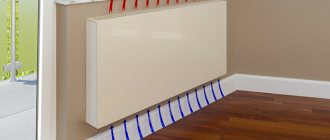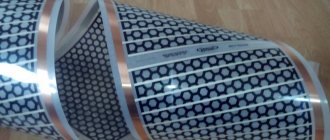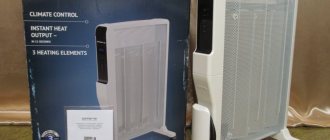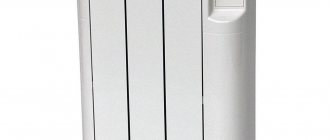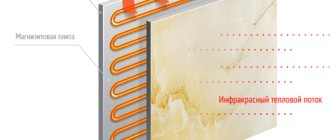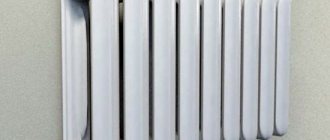An electric convector, like a life preserver, helps cope with low temperatures in our homes during the off-season. The management company has strict regulations for supplying heat to apartment buildings, but the weather has its own, uncoordinated schedule. Solving the problem of discomfort today is not difficult; you just need to go to the nearest store and buy a heater.
Let us make a reservation that the review will not contain an economic comparison of the option of completely replacing the traditional heating system of a house with heating the home using an electric convector. We consider polemics on this issue to be completely inappropriate. Today we are trying to figure out how profitable it is to buy an electric convector, solely in terms of its operation as an additional source of thermal radiation in our apartments.
How does it work
Note!
The operating principle of the described device is based on the phenomenon of convection. From the physics course we know that cold air is heavier than warm air, it is located in the lower part of the room, heated air masses gradually rise upward. Due to such movements, the entire air space in the room is heated. The convector operates according to a simple algorithm. At the bottom of this device there is a heating element (it is also called a heat exchanger). To increase the volume of air passed through, this part is made in the form of a radiator with several flat fins. The angle of their inclination regulates the direction of heated air flows. The heat exchanger is covered by a protective metal casing.
According to the energy carrier used, all convectors can be divided into the following types:
- Devices powered by electricity;
- Gas convectors;
- Mermen.
Design of a convector heater
At the top, as well as at the bottom of the convector body, there are several holes for sucking in cold air and transporting heated air. Structurally, it is made in such a way that the body of our device does not have direct contact with the heat sink, so the casing does not heat up and does not transfer heat. A similar transfer of heat resources occurs in water and oil radiators.
In everyday life, electric type convectors are mainly used. Water appliances have lower efficiency indicators; they differ from analogues in their significant overall dimensions, so they are installed in places where traditional water radiators are installed in niches under windows. Gas equipment, despite the possibility of saving energy resources, for some reason is not popular among consumers.
Principle of operation
A convector heater has a body with holes in the upper and lower parts. Cold air enters the equipment through the lower openings, is heated inside the housing using heating elements, and then rises to the top of the room. Circulation is carried out naturally, without the use of fans. Although some models use forced air circulation.
Modern equipment has thermostats that allow you to set the required heating temperature.
For uniform heating, it is recommended to install a convection heater above the windows. The equipment draws in cold air, which heats up inside. Thus, a kind of thermal curtain is obtained. Therefore, it is better to install not very powerful devices over each window than one powerful one over one opening.
pros
All models of the heaters under consideration, regardless of type, may have different overall dimensions. Some of them are equipped with built-in sensors and many additional functions. The main advantages of convectors are:
- Quiet operation. This characteristic is due to the absence of a fan in the device that hums;
- Possibility of installing the device on various surfaces (on the floor or wall, there are models that can even be installed on a windowsill);
- Beautiful design that will allow the installation to “fit” into any interior;
- Low heating temperature of the case, on average 60 degrees, maximum parameters - 90 degrees;
- Large models have wheels for easy movement around the room; lightweight devices can be mounted on the wall;
- When heating a room with a convector, oxygen is not burned;
- Devices can be left unattended;
- Long-term operation. Many manufacturers provide a 10-year warranty on the product.
Operating principle of the convector
Safety rules for placing and using a convector
To ensure uninterrupted, safe and long-lasting operation of the device, follow several important rules.
Prices for oil convectors
oil convector
- Do not install the convector in close proximity to an outlet. The minimum distance to it should be 800 mm. At the same time, keep in mind that the standard cable must reach it, since it is not recommended to use carriers and extension cords for constant operation of the device.
- Do not dry things on a convector! Even if your appliance has an automatic shut-off function, there is always a chance that it will not work. This may cause a fire.
- If the room has high humidity, it is better to give preference to high-quality devices (with a degree of protection IP24 and higher).
- Clean the room more often and periodically remove dust from the surface of the convector.
Choose a device with a degree of protection of at least IP24.
An electric wall-mounted convector is an excellent device that can heat a room in a short time, making your stay in it pleasant and comfortable. To ensure this continues for many years, choose your device wisely, and when using it, do not be lazy to follow simple rules. Then no problems will arise, and your home will be warm and comfortable in the most inclement weather.
Minuses
Despite the huge number of advantages, convectors also have negative qualities. The disadvantages of such devices include:
- Low noise level when warming up;
- Impossibility of replacing the heating element at home;
- The absence of a fan affects the rate at which the room warms up.
Note! The movement of well-heated dry air in a room affects the well-being of allergy and asthma sufferers. The ideal option for such people would be a convection air conditioner equipped with a humidifier.
Frame
When choosing a convector, you should also pay attention to the housing.
Firstly, you need to take into account the height of the device; the speed of air movement inside the housing depends on it, which ultimately affects the efficiency of its operation.
A convector with a height of 50 cm is considered optimal. This criterion also applies to floor convectors, but it is not its height that is taken into account, but its width.
Secondly, you need to take into account the thickness of the walls of the housing, because its walls also participate in heat exchange. Therefore, the thicker the walls of the housing, the higher the heat transfer will be, which means the efficiency of the device itself will be higher.
Which is better: oil or convector
We have already described the principle of operation, advantages and disadvantages of convectors, and now we will get acquainted with the main technical characteristics of the oil radiator. Such devices are most often used to heat air in a private house, country house or city apartment. To get started, you need to connect the device to a power source and set the required temperature on the thermostat.
Oil radiator
This heater consists of a metal body made in the form of a radiator. Mineral oil is poured into the middle of the container, which heats up and transfers heat from the heating element. A rheostat is built into the device, which allows you to turn off the device when a certain temperature is reached.
The heater is equipped with protection against accidental tipping. In this case, the heating element turns off.
The advantages of oil radiators include:
- Silence;
- Low cost;
- The ability to move the device around the apartment to warm up the desired room.
When choosing a radiator heater in a store, pay special attention to the power of the device. In this case, 1 kW of consumed electricity is calculated for 10 m2 of usable area of the room. The power consumption range is from 1 to 2.5 kW. Some models have a switch-on timer, which allows you to warm up the room at the right time.
Variety of oil heaters
Now let’s take a look at the comparative characteristics of these two heaters:
- The first important nuance of choice is efficiency. Here it is necessary to give preference to convectors, because they consume 25% less electricity;
- The second parameter is the warm-up time. When turned on, the convector immediately heats the air, its efficiency can exceed 95%. For the second device, the heating element is first heated, then the oil, the metal body and finally the air in the room;
- The next important characteristic is ease of operation (movement). Convectors have small overall dimensions; they can not only be placed on the floor, but also hung on the wall. Oil radiators are massive, their weight can reach up to 25 kilograms, and they are not suitable for wall installation. The unit has wheels for more comfortable movement, and if you need to bring the unit to the 9th floor in a building with a non-working elevator;
- Operating period. According to the technical specifications, the convector can last at least 5 years, but in practice it turns out to be longer. High-quality oil radiators also have a huge service life, but cheap Chinese models can crack the metal, which leads to oil leaking from the body;
- And the last characteristic is the price of the device. Here the undisputed leader will be oil heaters.
Convector is a better option compared to oil radiator
Conclusion: When comparing these two heaters, it is recommended to give preference to convectors.
Equipment selection criteria
To determine which convector is best installed in a particular room (electric, water, gas), you need to consider the operating conditions and installation of the radiator. The power and dimensions of the equipment are also taken into account. Let's consider the selection criteria in more detail.
Installation
There are two main types of radiators: stationary and mobile. The first ones are installed in the designed position without the possibility of movement. These are all water and gas radiators, some electric. This group includes heaters for hanging, built into walls or floors. Equipment with a network connection can be classified as mobile; the main thing is to place the cable safely.
Mobile model of a heating convector Source ventoprofi.ru
Which is better: infrared or convector
Infrared heaters appeared on the domestic market relatively recently. Such devices operate on the principle of transmitting thermal waves. In this case, infrared radiation heats not the air in the room, but the surrounding objects. Subsequently, heat is transferred from the heated surfaces. The heaters described can be mica, gas or lamp.
The most popular type is considered to be a lamp installation. Such devices can be mounted on walls or ceilings. Gas products heat the metal casing until it begins to transmit heat waves to the surrounding space. In mica models, the heating source is considered to be large metal plates, the surface of which is covered with mica.
We have already dealt with the advantages of convectors, and now let’s talk about the advantages of infrared heaters:
- Quiet operation;
- Rapid heating of object surfaces;
- Economical energy consumption;
- Safety for human health, except for gas appliances.
Infrared heater
When comparing these two heaters, you should pay attention to similar qualities, for example, quiet operation, the ability to mount the device on the wall. Both models will fit perfectly into the design of any room, but they also have differences:
- For small rooms with good thermal insulation, a convector would be an ideal option;
- An IR heater can be used in large rooms that are simply impossible to warm up completely. The use of such a device will localize heat in individual areas.
Environmental friendliness
Many users compare convectors and radiators on the basis of environmental friendliness. This issue needs to be looked into more closely. Since both heaters operate on convection, dust will rise up in any case. It is invariably picked up by currents of heated air. You will have to come to terms with this fact when purchasing a convector or radiator.
It should also be said that some sellers of the equipment presented claim that these heaters burn oxygen. However, according to the laws of physics, this process is impossible even in an oil radiator, not to mention a convector.
How to choose for a dacha
When choosing the heating device in question for use in the country, you should pay attention to the following parameters:
- Safety of use of the device;
- Durability indicators;
- Price;
- Economical use of electricity or other coolants.
Convector heater in the interior of a room
When choosing between a wall-mounted and floor-mounted model, you need to take into account the fact of using the device. Many types of electric convectors are fixed to the wall surface, but if there is a need to move the heating device, it will be necessary to purchase additional equipment (wheels, protection from heating during accidental tipping).
The height of floor convectors does not exceed 20 centimeters, they are narrow and long. Wall-mounted models reach 50 centimeters in height. According to experts, devices that are located as close to the floor surface as possible have maximum efficiency, because heated air moves from top to bottom. In this regard, it is better not to buy wall-mounted equipment, or install such devices as close to the floor surface as possible.
When purchasing such devices, you need to pay special attention to the material and workmanship of the case, its overall dimensions, and design. Here you need to take into account the height of the body: the larger it is, the greater will be the air flow speed or the convector properties of the heater.
Skirting convectors up to 20 centimeters in height heat the air well due to their significant dimensions; their length can reach up to 2.5 meters. A tall (up to 60 centimeters) heating device, in which the speed of air flow increases, will be more compact.
It is better to install the convector closer to the floor
Note! Before purchasing a convector, it is advisable to look at user reviews about a particular model. People who have used similar heating devices usually point out their advantages and disadvantages.
Video description
In this video, the master talks about the difficulties and problems that can be encountered when installing a water convector with water heating:
terms of Use
For dry rooms, you can choose any convector heater. For a kitchen or bathroom, it is necessary to consider the degree of protection of the heating element and control unit in the case of electrical equipment. In addition, it is necessary to take into account the heating temperature of the housing in order to prevent the occurrence of burns or fire of surrounding objects and decorative trim.
The second point can be eliminated using devices that are equipped with an automatic overheating sensor. It turns the equipment off and on when the set temperature thresholds are reached. Another solution is to install a thermostat. This device allows you to independently adjust the heat output of a convection heater.
Convector with thermostat Source elektro-teh.com
Power and efficiency
For a temperate climate in Soviet times, calculations were made. As a result, even today it is believed that 1 kW of energy must be taken into account per 10 square meters of area. It is worth noting that such a guideline is relevant for a house in which there is practically no heat loss; the ceiling height is limited to 2.7 meters. That is, for constant convector heating of dilapidated housing or with high ceilings, you need to increase the power. The additional heat source can be selected with a lower value relative to the reference.
The efficiency of radiators depends not only on the design of the basic components and its power. Additionally, the unit can be equipped with a fan. It provides forced movement of heated air, which speeds up the process of warming the space in the room.
The best heaters
Next, we will describe several popular wall and floor models of convector heaters. We will pay special attention to their technical characteristics, advantages and disadvantages, which are taken from real consumer reviews.
Wall mounted
The Ballu BEC/EZER-1500 heater with two-level power control and built-in display effectively warms a room up to 20 m2. Such a device has a turn-on timer and built-in tip-over protection. If necessary, the manufacturer can include in the delivery set special wheels for operating the convector on the floor.
Convector heater Ballu BEC/EZER-1500 with wheels included
The main advantages of Ballu BEC/EZER-1500 are silent operation, quick heating of the room, convenient control, and affordable cost. Disadvantages: clicks of the regulator, hard buttons, inability to warm up the room above 20 degrees Celsius. There are defects: incorrect assembly of the heating element. The price of the model is 2500 rubles.
The wall-mounted convector heater Stiebel Eltron CNS 150 S was highly appreciated by consumers. This device operates from a heating element with a power of 1.5 kW, its operation is controlled manually. There is a thermostat on the moisture-resistant case. The heater is equipped with protection against overheating and the influence of negative temperatures. Cost 6330 rubles
The main advantages of this convector include: silent operation, muffled clicks of the regulator relay, high speed of heating the room. No deficiencies found.
Stiebel Eltron CNS 150 S
Another model of the Timberk TEC.E3 M 2000 is designed for heating rooms with an area of 24 m2. This device operates from a 220-volt power supply; there is three-level power control by turning on several heating elements of 2, 1.15 and 0.85 watts. The convector has a moisture-proof housing and weighs 5.3 kilograms.
The advantages of Timberk TEC.E3 M 2000 are its affordable price of 2912 rubles, low electricity consumption, the ability to quickly warm up the room, and silent operation. Disadvantages: short cable, poor build quality, heater dries out the air.
Timberk TEC.E3 M 2000
Heater Ballu BEP/EXT -1000 with three-level power control. This small-sized device weighs only 5.8 kilograms and is protected against overheating and exposure to negative temperatures. The convector is designed for heating small rooms with an area of 15 m2. The cost of the unit is 3300 rubles.
The main advantages of Ballu BEP/EXT -1000 are: remote control of the device, small dimensions, functionality, quick heating of the room. Some buyers point out one drawback of this model - the creation of low temperatures in the room.
Ballu BEP/EXT -1000
Building electrical wiring requirements
Convectors have different powers, on average 0.5–3 kW. If the house is old, then its wiring simply will not withstand maximum loads.
When installing the device, it is recommended to take into account its power:
- No more than 2 kW. Can be connected to any electrical wiring. The rating of the input circuit breaker must be at least 10 A.
- 2–2.5 kW. You will need aluminum wiring with a cross-section of 2.5 mm2 or copper 1.5 mm2, as well as a 16 A socket and a 16 A machine rating.
- More than 2.5 kW. A separate cable with a cross-section of at least 2.5 mm2 for copper is used. In addition, it is necessary to install a separate circuit breaker with a rating of 16 A.
When connecting a convector, it is better not to use extension cords of dubious quality. The wires in them have a small cross-section and will simply melt under heavy loads.
Floor-standing
The Ballu BEP/EXT -1500 convector is designed for heating rooms with an area of 20 m2. This device operates on a 220-volt power supply and has several power switching modes, which allows you to achieve the optimal temperature for heating the room. The model is equipped with special wheels for easy movement around the room, there is protection against overheating and accidental tipping, there is a control panel and a timer. The price of the model is 4220 rubles.
The advantages of the model are: beautiful appearance, a 3-year warranty on the product, low power consumption. Cons: clicking noises are heard when the thermostat operates, an unpleasant smell when first heating up, the display is bright.
Ballu BEPEXT -1500 differs from the previous model in size and power
The Electrolux ECH/AG-1000MFR convector with a power of 1 kW is designed for heating small, including wet rooms with an area of 15 m2. The controls in this device are mechanical, it is possible to control the temperature, there is a dust filter, as well as protection against overheating. The heater has a moisture-proof housing, the price of the model is 2,450 rubles.
The advantages of Electrolux ECH/AG-1000MFR include: excellent functionality, fast heating of the room, small overall dimensions, absence of foreign odors during operation of the device. No deficiencies found.
Convector Electrolux ECH/AG-1000MFR
Thermor Evidence 2 Elec 1500 with a power of 1.5 kW is designed for heating rooms with an area of 15 m2. This model has electronic control, it is possible to adjust the temperature automatically. The device has a waterproof housing and protection against overheating and frost. The price of Thermor Evidence 2 Elec 1500 is 4,400 rubles.
The main advantages of this convector are: beautiful appearance, ease of use, quick heating of rooms, and can withstand significant voltage drops. The disadvantages include the high cost of additional equipment.
Thermor Evidence 2 Elec 1500
Hyundai H-HV14-20-UI540 heater with two heating elements of 1.25 and 0.75 kW can operate in three modes. At maximum power, it is possible to heat rooms with an area of 24 m2. The device connects to a 220-volt household power supply, is equipped with a digital display, and has mechanical control. The device has built-in overheating protection, its price is 1,590 rubles.
Hyundai H-HV14-20-UI540
The advantages of the Hyundai H-HV14-20-UI540 include affordable cost, the ability to save energy by turning off the temperature relay when the room is intensively heated, fast heating, small dimensions and weight. Disadvantages: foreign odors when the device is first started, high body temperature, thermostat clicks.
Types of devices
There are two types of inverter heaters - infrared and gas. The first type is used for heating residential and utility rooms, as well as cottages and verandas. Such equipment tolerates moisture and precipitation well.
The gas heater runs on natural and liquefied fuel. Its main advantage is its ability to maintain heat over large areas. This is a very productive device that operates with low fuel consumption. It is very easy to use and mobile.
Inverters differ, at a minimum, in heating power
New generation air conditioners
Usually this equipment is associated only with cooling the air in the apartment. But it is not so. Inverter air conditioners can not only cool, but also warm the living space.
Such air conditioners are used in apartments and offices. But if the temperature in the winter is -26 degrees, the device will not be able to cope with heating the room alone. This option will be inconvenient for use in a country house or garage. The air conditioner is environmentally friendly. During its operation, no fuel is burned, therefore there are no emissions of harmful substances into the atmosphere.
Inverter air conditioners have many advantages. The following advantages of the systems are highlighted:
- Adjustment of the desired temperature occurs quickly.
- The device operates almost silently. This is achieved through built-in fans operating at low speed.
- Compared to other models, an inverter air conditioner saves up to 65% of electricity.
- When using the system, the occurrence of drafts is excluded, since there are no sudden temperature changes.
However, each mechanism has its drawbacks. An inverter air conditioner has the following disadvantages:
- Higher price compared to other types of systems.
- Sensitive electronics that respond to voltage fluctuations.
- Inability to turn on the compressor at temperatures of -10 and +42 degrees.
- Difficulty in selecting spare parts.
Equipment Manufacturers
The leader in the production of inverter air conditioners is Japan. It was in this country that such systems were first developed. Daikin produces wall-mounted equipment for residential maintenance. Air conditioners have minimal noise levels and also purify the air. Some models are equipped with a special energy saving sensor. If there is no one in the room for more than 20 minutes, the system switches to this mode.
A large selection of inverter air conditioners is also presented by Toshiba. The models have an original and effective design, suitable for any modern interior. The equipment reaches the set temperature 25% faster than other heaters. The system does not require large amounts of electricity to operate; on the contrary, it is consumed 2 times more economically. The models are equipped with an air filter that allows you to destroy 99% of pathogenic bacteria in the room.
Installation depth in floor and fan
Now let's consider a situation where in your apartment the collector wiring and heating are done on the floor.
Firstly, do not take the word of sales managers. Absolutely all in-floor convectors heat very poorly. And the shallower the depth of their installation, the worse they do it.
In fact, in central Russia, only the most powerful models with an installation depth of 120 mm work normally. And only if they have an additional fan.
That is, specimens with a depth of 80 and 100 mm practically do not work in latitudes with cold temperatures.
From such work you will get foggy windows, and the temperature in the room will not exceed 17 degrees.
Sometimes there is even mold on the walls and ceiling.
But still, there are those that more or less work (with a fan and a depth of 12cm). Let's look at them.
Let's start with the fact that the presence of a fan is:
additional troubles with electrics on the floor
additional problems with turning it on and off
extra electricity costs
and most importantly, the constant noise from its operation
If you want a silent and quiet fan, then don’t be surprised at the price. For such models it starts from 50 thousand. rubles and reaches 200 thousand.
If we take the same ordinary radiator battery for comparison, then with the same heat transfer parameters, all your costs will be limited to 5 thousand.
At the same time, the fan itself is a very short-lived thing. No convector manufacturer provides a warranty of more than 1 year.
It is also very difficult to find manufacturers who sell fans separately. This means that if it breaks, you will most likely have to buy the whole convector again.
Installation
To install a convector as part of the heating system, the following work is carried out:
- Placement and fixation of the housing in the location of the heater specified by the customer (wall, in-floor space, ceiling);
- Installation of a heat exchanger, fan and other elements in the convector housing;
- Installation of shut-off and control valves, thermostats or other elements for regulating the temperature regime of the outgoing heat flow;
- Connection to the heating system.
Due to the design differences between water and electric convectors, the sequence of work to start them up to heat a home is carried out according to different algorithms.
Mermen
Connection diagram of a water convector to a heating system
The figure shows a diagram of a conventional water convective heating device (this diagram is valid for both wall-mounted and in-floor structures) using the following elements of connection with the riser of an already existing autonomous or central heating system:
- 1 – shut-off and control valve;
- 2 – coupling with external thread;
- 3 – coupling with internal thread;
- 4 – polypropylene pipe;
- 5 – thermostat;
- 6 – overall area of the convector (body and cover not shown).
When installing wall-mounted models, holes are drilled in the wall for fixing fasteners, on which the heater is hung. In the case of in-floor models, the amount of work is much greater, since it is necessary to prepare the in-floor space to place the convector housing box in it.
Electrical
Electric convectors are either hung on the wall on special fixing hooks, or installed on the floor on support legs with wheels. In this case, the following recommendations must be observed:
- The minimum height from the bottom of the convector to the floor plane is 20 cm;
- The minimum distance from the sockets to the heater body is 35 cm.
Reviews
Most reviews about convector heaters are positive. They don't make noise, heat the air well and look good. Dissatisfaction is expressed by customers who have not calculated the power of the device. The heating seems insufficient.
Owners of models that do not have wheels and handles (for carrying the device while it is hot) say that these parts would be very useful.
Many are unanimous that at first the devices emit a not very pleasant smell.
So. Convector heaters are a worthwhile addition to weak heating systems. They are used on loggias and dachas. Models with a moisture-resistant body are good for bathrooms. Electric models remain the most popular because they are the easiest to use and the price of the device is relatively low.
A fireplace is considered a luxury item, not a necessity. The high price makes one refuse to buy it. But it is quite possible to make a stove yourself. Do-it-yourself fireplace: step-by-step assembly instructions, example of ordering and finishing.
Do I need to purchase a heat accumulator for a heating boiler? Here you will find the answer to this question.
